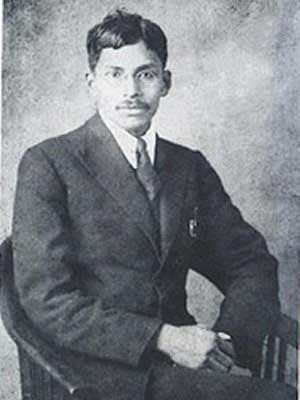
Megh Nad Saha (Bangla:মেঘনাদ সাহা) (Devanagari: मेघनाद साहा) (October 6, 1893 – February 16, 1956) was an Indian astrophysicist. He was born on 6 October, 1893 in Shaoratoli village near Dhaka (in present Bangladesh). He had his initial schooling at Dhaka Collegiate School, and later moved to Dhaka College. He was also a student at the Presidency College, Kolkata; a professor at Allahabad University from 1923 to 1938 and thereafter a professor and Dean of the Faculty of Science at the University of Calcutta until his death in 1956. He became Fellow of the Royal Society in 1927. He was president of the 21st session of the Indian Science Congress in 1934.
In his book, The Scientific Edge, the noted physicist Jayant Narlikar observed:
"Meghnad Saha’s ionization equation (c. 1920), which opened the door to stellar astrophysics” was one of the top ten achievements of 20th century Indian science [and] could be considered in the Nobel Prize class." [1]
The impetus given to astrophysics by Saha’s work can scarcely be overestimated, as nearly all later progress in this field has been influenced by it and much of the subsequent work has the character of refinements of Saha’s ideas.”
S. Rosseland in Theoretical Astrophysics (Oxford University Press, 1939) [2]
Scientists are often accused of living in the “Ivory Tower” and not troubling their mind with realities and apart from my association with political movements in my juvenile years, I had lived in ivory tower up to 1930. But science and technology are as important for administration now-a-days as law and order. I have gradually glided into politics because I wanted to be of some use to the country in my own humble way.”
Meghnad Saha [3]
He (Saha) was extremely simple, almost austere, in his habits and personal needs. Outwardly, he sometimes gave an impression of being remote, matter of fact, and even harsh, but once the outer shell was broken, one invariably found in him a person of extreme warmth, deep humanity, sympathy and understanding; and though almost altogether unmindful of his own personal comforts, he was extremely solicitous in the case of others. It was not in his nature to placate others. He was a man of undaunted spirit, resolute determination, untiring energy and dedication.”
D. S. Kothari in Biographical Memoirs of Fellows of the National Institute of Sciences of India, Vol .2, New Delhi, 1970 [4]
Son of Jagannath Saha, he belonged to a poor family and struggled to rise in life. He was fortunate to have brilliant teachers and class fellows. In his student days, Jagadish Chandra Bose and Prafulla Chandra Roy were at the pinnacle of their fame. Amongst his class fellows were Satyendra Nath Bose, Jnan Ghosh and J. N. Mukherjee. In later life he was close to Amiya Charan Banerjee, a renowned mathematician at Allahabad University.
He invented an instrument to measure the weight and pressure of solar rays. He produced the famous equation which he called 'equation of the reaction - isobar for ionization' which later became known as Saha's "Thermo-Ionization Equation", or the Saha Equation. According to the Scientific American, this equation became the foundation for the field of astrophysics.[citation needed]
Megh Nad Saha's basic work was on the thermal ionisation of elements and it led him to formulate what is known as the Saha equation. (When an element is heated to a very high temperature, the electrons in its atom get enough energy to break free from the atom. This process is known as thermal ionisation.) Saha's equation is one of the basic tools for interpretation of the spectra of stars in astrophysics. By studying the spectra of various stars, one can find their temperature and from that, using Saha's equation, determine the ionisation state of the various elements in the star. He was also associated with building several scientific institutions like the Physics Department in Allahabad University and the Institute of Nuclear Physics in Calcutta. He founded the journal "Science and Culture" and was the editor till his death. [5]
Saha was the leading spirit in organizing the scientific societies like the 'National Academy of Science' (1930), the 'Indian Physical Society' (1934), 'Indian Institute of Science' (1935) and the 'Indian Association for the Cultivation of Science' (1944). The lasting memorial to him is the Saha Institute of Nuclear Physics founded in 1943 in Kolkata.
He was also the chief architect of river planning in India. He prepared the original plan for the Damodar Valley Project.
See
Retrieved from "http://en.wikipedia.org/"
All text is available under the terms of the GNU Free Documentation License

